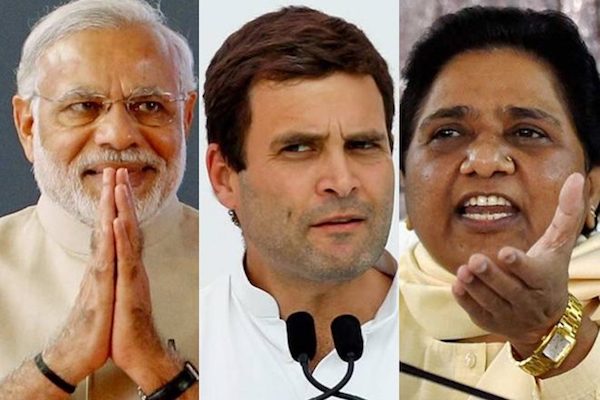
Modi, Mayawati, Rahul likely in Prime Ministerial race

“It’s too early to write off Modi’s prospects. He remains a popular figure and powerful orator, and his party is India’s best funded and best organized. Yet it is clear Modi’s tax-and-spend model of development is failing to enthuse voters. Tuesday’s results suggest discontent in the Hindi heartland, a region that in 2014 gave the BJP two-thirds of its parliamentary seats. Simply put, Modinomics is not working. When Modi was elected, he promised to invigorate the economy by providing “maximum governance” with “minimum government” and replacing red tape that would have allowed market forces to play a larger role in India’s inefficient economy.”
It could be anybody’s guess. But what appears for now, the 2019 general elections are more likely to throw up a hung parliament. Modi as Prime Minister for another term may not be a certainty. A dark horse like Mayawati could be the Prime Minister. Rahul Gandhi may also not be ruled out.
In the recent elections held in Madhya Pradesh, Rajasthan and Chhattisgarh, Modi’s BJP crashed to unexpected electoral defeats. The Congress has won in Rajasthan and Chhattisgarh and fell just short of an outright majority in Madhya Pradesh.
Madhya Pradesh and Chhattisgarh are widely regarded as BJP strongholds. To put the results in context, India’s main opposition party has been consistently losing elections since it was routed in the seismic 2014 elections that brought Modi to power, winning less than 20% of the popular vote and securing only 44 of the 543 seats. Prior to its latest victories ,the Congress was in power in only two large states.
The BJP won 62 of the 65 parliamentary seats in these three key states in the last general elections. Rajasthan, Madhya Pradesh and Chhattisgarh are also part of a bellwether region – the Northern Hindi speaking heartland of India – that gave the BJP and its allies 203 of the 225 seats that they won in 2014. So the Congress’s robust performance – it gained 163 assembly seats here since 2013 state polls – is a shot in the arm for the party. It will bolster the morale of party workers, make it more acceptable to skeptical regional allies, and boost the image of its leader Rahul Gandhi. It will also send out the significant message that Modi’s BJP is not invincible and can be defeated. All this will help Congress gain some much-needed momentum in the run-up to next year’s crucial elections. However, these state polls may be an unreliable barometer for next year’s big elections.
Modi won the general elections in 2014 with only 31% of votes. Today, his opposition is ruling Punjab, Delhi, West Bengal, Tamil Nadu, Kerala, Andhra, Telangana, Karnataka, Madhya Pradesh, Rajasthan, Chhattisgarh, representing majority of 535 parliamentary seats. Even in his home state of Gujarat, Modi’s party won only marginally. For ambitious political leaders of these States Mayawati-Samajwadi coalition could be very attractive to defeat Modi. Such an outcome could create power in the center for Modi’s opposition, even excluding the Congress.
There was considerable anti-incumbency against the BJP in these states – the party was trying for a record fourth term in both Madhya Pradesh and Chhattisgarh. People in Rajasthan have a consistent record of voting out the incumbent after one term. The BJP workers can take solace from the fact that the party still put up a spirited fight in two of the three states, despite the formidable odds of anti-incumbency. Secondly, the majority of seats in three states witnessed bipolar contests between the BJP and the Congress. In general elections, regional parties will hold the key. Next year much will depend on the kind of strategic regional alliances the Congress is able to stitch up and sustain in different states. Thirdly, one of the BJP’s greatest strengths is having capable leaders in several states, many of whom who have completed more than one term. Hobbled by dynastic politics, the Congress has failed to groom young local leaders, depending mainly on the charisma of the Nehru dynasty. Also, the Congress appears to lack political imagination and has been unable to produce a powerful alternative to the BJP.
“It seems to be courting on anti-incumbency to do the work, a complacent attitude that has made the BJP competitive in areas where it has gathered genuine discontent, against the lack of development outcome, unemployment and rural distress,” says political scientist Gilles Verniers of Ashoka University.
In their new book, Ideology and Identity, political scientists Pradeep K Chhibber and Rahul Verma from the University of California, argue that India “is no longer led by a Western oriented elite, and citizens have voted into power politicians closer to their roots, politicians who represent small town socially conservative values, in the BJP or regional parties”. This is a shift of power to a “more conservative and vernacular elite” which seems to have escaped the Congress.
WHAT REMAINS ABUNDANTLY CLEAR IS THAT THE 2019 GENERAL ELECTION WILL BE A REFERENDUM ON MODI, AND, WHO CAN LEAD IN WINNING COALITIONS AND FORM THE GOVERNMENT?
Modi’s grandiose promises – specially to create more jobs and increase incomes of farmers – have begun to bite. Lack of jobs and declining farm incomes will be the deciding issues next year, although whether the farmers will vote as an “angry bloc” against what is now being perceived as an “arrogant” government will become clear closer to the Summer polls.
But the failure to offer an alternative narrative of hope to the people will make it difficult for the Congress and its often fractious allies to mount a credible challenge to Modi, who still remains the BJP’s star vote-catcher.
MAYAWATI COULD EMERGE AS THE HERO OF THE OPPOSITION TO MODI
Mayawati is central to opposition plans to take government because rising sectarian tensions have led to increased Dalit support. A woman who represents millions of India’s poorest citizens (India has 300 million poor) is now India’s most sought after politician. Mayawati, an icon of the country’s traditionally oppressed Dalits who were once known as “untouchables,” is central to opposition efforts to prevent Prime Minister Modi’s reelection in 2019. With rising sectarian tensions leading to stronger political unity among Dalits – a swing force that consists of about 16.6 percent or 200 million of India’s population – many parties are turning to Mayawati to forge an alliance ahead of general election.
Mayawati, who was the former Chief Minister of Uttar Pradesh may be a front runner for Prime Minister if there is a hung parliament and neither Modi’s BJP nor Rahul Gandhi’s main opposition Congress Party can form government, said Ajoy Bose, a Delhi based political analyst who wrote a biography of the 62-year-old.
“Almost from a position of political oblivion, there are signs of the resurrection of Mayawati,” said Bose. “She has definitely regained ground dramatically. There is a possibility that she could even be a Prime Ministerial candidate – the whole idea of having such a prominent Dalit leader as Prime Minister will be tempting for a lot of other parties as it will give them some edge.”
In Uttar Pradesh, which holds the key to forming the national government, Modi’s ruling National Democratic Alliance would lose 35 seats compared to the 2014 elections if Mayawati’s Bahujan Samaj Party and the Samajwadi Party joined forces, according to one poll. Similarly, Congress could make sizeable gains in the State if it joins hands with those parties. Another survey, from India Today, predicted an alliance of opposition parties would come out neck and neck with Modi’s ruling coalition.
Modi won in the general elections in 2014 with only 31% of votes. Today, his opposition is ruling Punjab, Delhi, West Bengal, Tamil Nadu, Kerala, Andhra, Telangana, Karnataka, Madhya Pradesh, Rajasthan, Chhattisgarh representing majority of 535 parliamentary seats. Even in his home state, Modi’s party won only marginally. For ambitious political leaders of these States Mayawati-Samajwadi coalition could be very attractive to defeat Modi. Such an outcome could create power in the center for Modi’s opposition even excluding the Congress.
Sadanand Dhume of the WSJ wrote: “It’s too early to write off Modi’s prospects. He remains a popular figure and powerful orator, and his party is India’s best funded and best organized. Yet it is clear Modi’s tax-and-spend model of development is failing to enthuse voters. Tuesday’s results suggest discontent in the Hindi heartland, a region that in 2014 gave the BJP two-thirds of its parliamentary seats. Simply put, Modinomics is not working. When Modi was elected, he promised to invigorate the economy by providing “maximum governance” with “minimum government” and replacing red tape that would have allowed market forces to play a larger role in India’s inefficient economy.”
(Ven Parameswaran of Scarsdale, N.Y. is a Senior Adviser to the Imagindia Institute, a think tank in New Delhi)





Be the first to comment